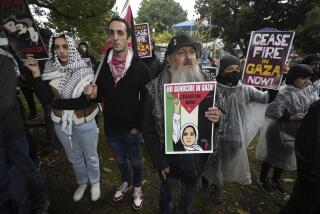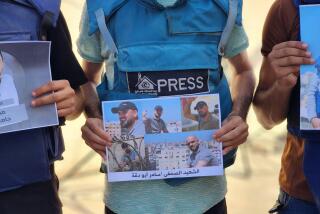‘Footnotes in Gaza’ by Joe Sacco
Joe Sacco’s “Footnotes in Gaza” is not a sequel to his 1996 book “ Palestine,” although it’s tempting to read it as such. Both are works of comic-book journalism that take place in the occupied territories, and both offer a ground’s-eye-view of situations that seem too big, too incomprehensible for us to wrap our minds around. But while “Palestine” is a portrait of its moment, an account of Sacco’s visit to the West Bank and Gaza during the early 1990s, “Footnotes in Gaza” is a more expansive effort. Built around two forgotten incidents (the 1956 mass killings of Palestinians in Rafah and Khan Younis), it is a book that digs deep, exploring the relationship of past and present, memory and experience -- rigorously reported yet always aware of the elusive nature of testimony, the way that stories solidify and harden over time.
This is especially true in the Middle East, where battles get fought again and again and the personal is the political in a way that we in the United States can never truly understand. “As someone in Gaza told me,” Sacco writes in a brief foreword, “ ‘events are continuous.’ Palestinians never seem to have the luxury of digesting one tragedy before the next one is upon them.” This is a key idea, and it’s essential to “Footnotes in Gaza,” with its uneasy balance between history and forgetting, between the power of knowing and the futility of the past.
Throughout the book, Sacco shows how much and how little things have changed by the use of what we might call time-fades: paired images that evoke a scene in the 1950s, followed by the same scene in the present day. The most striking of these comes at the climax of his account of the Khan Younis killings, in which he offers side-by-side illustrations, the first showing bodies piled against “the ruins of the 14th century castle, which now forms one side of the town square,” the second featuring the same castle half a century later, its walls festooned with handbills and graffiti, cars in a crowded row where the bodies once had been. Time marches on, Sacco means to tell us, and the past is only prologue if we pay attention to what it says. Yet even in a place so bound up by history, “[w]hat good would tending to history do . . . when [people] were under attack and their homes were being demolished now?”
Here we have the central conundrum of “Footnotes in Gaza,” which moves back and forth from the furious weight of history to the hopelessness of the present day. By way of emphasis, Sacco focuses -- as he did in “Palestine” and in his Bosnian war book “Safe Area Gora{zcaron}de” -- on individuals, while engaging in his own form of immersion journalism. In Rafah, he takes an apartment in the center of the refugee camp, against the wishes of his Palestinian guides. One, a resistance fighter named Khaled, tells him he might come under suspicion. “The camp has areas of resistance,” he says. “It’s better that you stay in a place Hani [Sacco’s protector] suggests.”
That’s a small moment, but an important one, for it suggests the larger scope of Sacco’s project, which is to humanize the situation (and its players) by placing himself directly in its midst. Khaled is a former Fatah member who now belongs to the armed Popular Resistance Committees, but he lives by a certain code. When he and some compatriots hear a sheik exhorting boys to rise up against the Israelis, they are sickened by the cavalier waste of lives. “I’ve heard him argue against suicide attacks on civilians,” Sacco writes of Khaled. “I’ve heard him advocate a two-state solution. I’ve heard him say he would be willing to cede his ‘right of return’ as a refugee for a chance to raise his family in peace.” And yet, Khaled also acknowledges that he is a killer, that “killing is not a huge thing for me.” It is in highlighting such apparently irreconcilable contradictions that Sacco brings the conflict down to the most human level, allowing us to imagine our way inside it, to make the desperation he discovers in Gaza, in some small way, our own.
The knock, of course, is that Sacco is in with the very people about whom he’s reporting, which colors his perspective in unsettling ways. That’s true, in one sense, but the take-away is more important than any bias and, regardless, his sympathies are not so easily categorized. Yes, he is on the side of the colonized over the colonizers, and yes, his book is built around a pair of Israeli atrocities, obscured by time though they might be. But his inquiry has more to do with the intractability of the situation than with any ideology or intent.
Nowhere is this as clear as when Sacco reproduces a eulogy for a kibbutznik killed by Palestinian infiltrators, delivered in 1956 by Moshe Dayan. “Let us not today cast blame on the murderers,” Dayan notes. “What can we say against their terrible hatred of us? For eight years now they have sat in the refugee camps of Gaza, and have watched how, before their very eyes, we have turned their lands and villages, where they and their forefathers previously dwelled, into our home.” It’s a stunningly empathetic statement -- perhaps the most empathetic statement in the book -- and it stands as an epitaph, not just for the dead of Rafah or Khan Younis, but also for everyone caught up in the endless turmoil of the Gaza Strip. Fittingly, it is Khaled who offers the Palestinian counterpoint. “It’s not a matter of victory,” he says in the closing pages. “It’s a matter of resisting till the end.” His posture, slumped, resigned, his face marked with sadness, tells us all we need to know about the toll.
Ultimately, that toll is what links past and present -- and perhaps Palestinian and Israeli. After all, as Sacco acknowledges, the Israelis have been victims of atrocities, as well. What is the value of history in such a landscape? How do we make sense of where we are? These are the primary questions raised by “Footnotes in Gaza,” and it is to Sacco’s credit as an artist and a journalist that he proposes no easy answers -- nor, indeed, any answers at all.
Ulin is book editor of The Times.
More to Read
The biggest entertainment stories
Get our big stories about Hollywood, film, television, music, arts, culture and more right in your inbox as soon as they publish.
You may occasionally receive promotional content from the Los Angeles Times.











